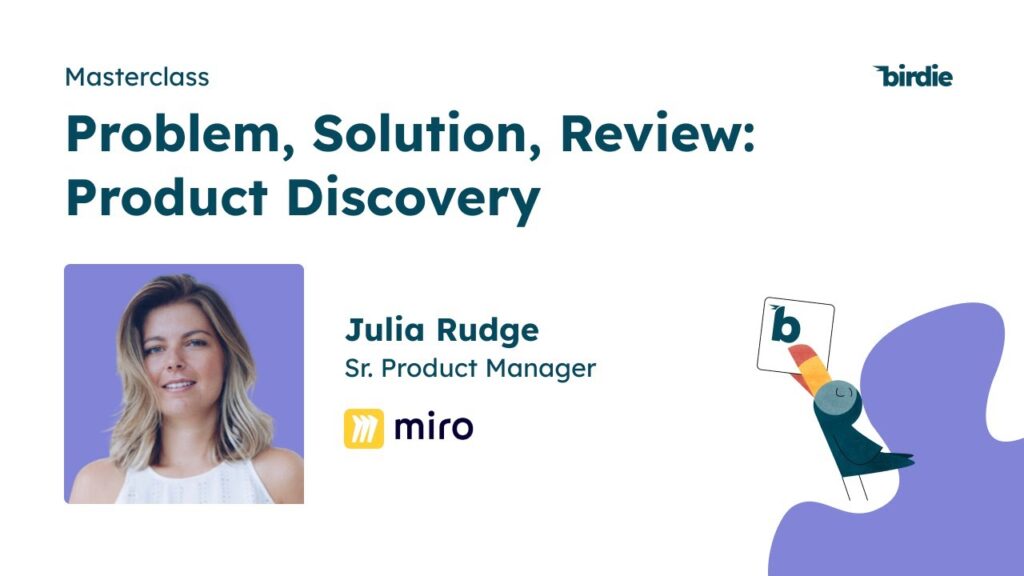
In our June masterclass, Julia Rudge, Senior Product Manager at Miro, shared valuable insights and experiences from her career as a Product Manager. With expertise in business, marketing, and product development, Julia has worked with companies ranging from startups to industry giants like Uber.
In this article, we’ll explore the key takeaways from Julia’s masterclass, including:
- the concept of product discovery
- the product development life cycle at Miro
- choosing validation strategies
- leveraging customer and stakeholder perspectives
Let’s dive right into it.
Understanding Product Discovery
Product discovery is the process of identifying and understanding customer and business needs to inform the development of successful products. At Miro, the product life cycle consists of three stages: the thinking stage, the building stage, and the shipping stage. The thinking stage focuses on validating the right product ideas, while the building stage ensures the selected ideas are executed effectively. The final stage involves evaluating the success of the product. Throughout this life cycle, continuous validation and discovery processes are crucial, enabling Miro to stay closely connected with its users.
Choosing Validation Strategies
When choosing a validation strategy, it is essential to consider the value and effort associated with each method. Julia emphasizes that validation should not be done just for the sake of it, but rather to derive meaningful insights. Thanks to advancements in AI, such as tools like Birdie, the effort involved in continuous discovery has been significantly reduced. Julia shares a set of criteria they consider when selecting the appropriate validation method:
- Product Maturity: The stage of the product, whether it’s in the early phase (zero to one) or the optimization phase (one to 100), influences the choice of validation strategy.
- Risk Assessment: Understanding the types of risks involved, such as value risk or viability risk, helps determine the appropriate validation approach. Different risks require different methods of validation.
- Timing: Timing plays a crucial role in the validation process. Instead of front-loading all the learning at the beginning, a continuous learning approach is preferable. The timing of validation affects the cost and value associated with it.
- Learning Methods: Not all insights can be acquired solely through user conversations. Observation, data analysis, and leveraging the expertise of UX researchers can provide valuable information. Choosing the right research format for each specific learning objective is vital.
- Leveraging Existing Knowledge: It’s important not to overlook what is already known. Previous research within the company or the team might hold valuable insights to be built upon. Reanalyzing data and user interviews can yield fresh perspectives without starting from scratch.
The Power of Intuition
While data-driven decision-making is crucial, Julia emphasizes the significance of intuition. Intuition should not be disregarded but instead complemented with quantitative and qualitative data. When intuition is combined with data, it strengthens insights and enables more actionable decision-making.
In the world of product management, there is no one-size-fits-all playbook. Product discovery requires a diverse toolbox of methods and approaches. By following the guidelines presented by Julia, product managers can enhance their understanding of customer needs, make informed decisions, and increase the chances of building successful products.
The continuous learning process, coupled with the right validation strategies and the integration of intuition and data, enables product managers to confidently navigate the complex landscape of product development.
Feedback Analytics Platform for a better product management strategy
Birdie helps product-centric companies better understand customers at scale to create product strategies to increase acquisition, conversion, and retention.
Related Posts
4 Steps to Leverage Qualitative Data to Improve Customer Satisfaction and Reduce Support Cost
After multiple iterations of our own methodology to help our customers increase their customer satisfaction [...]
Leveraging Customer Feedback Analytics to Enhance Customer Experience in FinTech
Leveraging Customer Feedback Analytics to Enhance Customer Experience [...]
Navigating the Path to SaaS Success: Insights from Henrique at Bill.com
In the fast-paced world of Software as a Service (SaaS), success isn’t just about building [...]
Product Leader’s First 180 Days: Insights from Esteban’s Masterclass on Scaling Product and Teams
In the ever-evolving landscape of product development, effective leadership can make all the difference between [...]
Leveraging AI and Behavioral Economics for Community Building and User Engagement
Today it’s really important for businesses to create active online communities and get users involved. [...]
From Product Management to the C-Suite: Navigating Your Path to Leadership
The journey from a product management role to a leadership position in the C-suite is [...]
Building and Scaling Feedback Loops for Effective Product Development
In the dynamic world of product development, feedback is the lifeblood that fuels innovation and [...]
Successful Product Discovery: 4 Key Insights from a Sr. Product Manager at Miro
Successful Product Discovery [...]